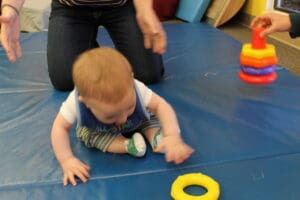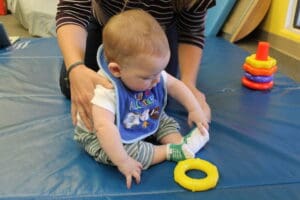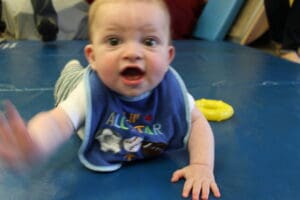What are transitional movements you may wonder. They are when a kiddo moves from one position to another. This can look like rolling, getting in or out of sitting, getting in or out of quadruped, getting up into standing, getting back down to the floor from standing, and the list can go on and on.
For many kids learning to transition between positions comes easily to them. However, this isn’t the case for all kids. There are many reasons that some kids may have to ‘learn’ how to transition and move. Some of those reasons may include weakness, motor planning challenges, increased time in ‘positional equipment’, and many others.
Transitions are important because they help your child learn how to move. They begin to understand that they can explore on their own. They can increase their independence with exploration and expanding their curiosity. It also helps them to learn more about their bodies as well as cause and effect. They learn to grade their movements and how to problem solve. They begin to understand and develop body awareness.
How can you help your kiddo develop and work on their transitional movements? Rather than pick them up and place them in a new position, help them to move into it. Another way is to set up the environment so that they are encouraged to explore. Here are a few ideas:
- Rolling – Instead of picking your kiddo up and placing them on their belly, use a toy and get them engaged and then help them roll over onto their belly so that they can get to the toy. Even if you don’t have time to get them engaged, you can still help them to roll so that they start to learn there isn’t some magic force that moves them from one place to the next!
- Sitting (from the belly or the back) – I’m probably going to start sounding like a broken record but the same ideas apply for all the areas I’m going to mention. Instead of picking your baby up and placing them in sitting, help them to get into the position on their own.
- You can do this almost anytime you are changing their diaper, just help them to move into sitting before you pick them up rather than picking them up from a lying down position.
- If they are already maintaining sitting independently you can also work on this from a sitting position. Have them lean over onto one arm and have a toy in front of them so that they have to push back up to get into sitting to reach for it.
- When your kiddo is in a sitting position you can help them move into a lying down position. You can also have them try to do this by putting toys just a little further out of reach so they have to move from sitting onto their belly to get it.
- Quadruped – This is similar to going from sitting to on the belly. If they are already sitting put your leg on one side of them and put a toy they like on the other side of your leg. Encourage for them to reach for the toy so they move over top of your leg (you may have to help them at first so they know what to do), keeping their legs on one side and their arms on the other. As they get stronger and willing to try the movement more you can take your leg out of the way. They may go all the way to their belly a few times but that’s the fun of trial and error and how they learn.
- Standing – Again, it’s all about finding what engages your child. Use an elevated surface that they can pull up on (not too high but not too low) and place something they really want on top. Help them to figure out how to pull/push into standing so that they see they can get to the toy they want!
As you noticed a lot of the concepts are the same. You want to make sure that their toys aren’t always right within their grasp, make them have to work a little to get to them. Don’t just pick them up and place them in a position, take a few extra seconds to ‘help’ them move to the new position. They begin to understand how to motor plan and problem solve so that they will begin to want to move and explore!


